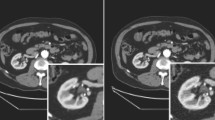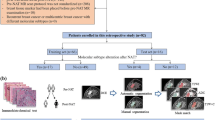Abstract
Objectives
To assess image quality and liver metastasis detection of reduced-dose dual-energy CT (DECT) with deep learning image reconstruction (DLIR) compared to standard-dose single-energy CT (SECT) with DLIR or iterative reconstruction (IR).
Methods
In this prospective study, two groups of 40 participants each underwent abdominal contrast-enhanced scans with full-dose SECT (120-kVp images, DLIR and IR algorithms) or reduced-dose DECT (40- to 60-keV virtual monochromatic images [VMIs], DLIR algorithm), with 122 and 106 metastases, respectively. Groups were matched by age, sex ratio, body mass index, and cross-sectional area. Noise power spectrum of liver images and task-based transfer function of metastases were calculated to assess the noise texture and low-contrast resolution. The image noise, signal-to-noise ratios (SNR) of liver and portal vein, liver-to-lesion contrast-to-noise ratio (LLR), lesion conspicuity, lesion detection rate, and the subjective image quality metrics were compared between groups on 1.25-mm reconstructed images.
Results
Compared to 120-kVp images with IR, 40- and 50-keV VMIs with DLIR showed similar noise texture and LLR, similar or higher image noise and low-contrast resolution, improved SNR and lesion conspicuity, and similar or better perceptual image quality. When compared to 120-kVp images with DLIR, 50-keV VMIs with DLIR had similar low-contrast resolution, SNR, LLR, lesion conspicuity, and perceptual image quality but lower frequency noise texture and higher image noise. For the detection of hepatic metastases, reduced-dose DECT by 34% maintained observer lesion detection rates.
Conclusion
DECT assisted with DLIR enables a 34% dose reduction for detecting hepatic metastases while maintaining comparable perceptual image quality to full-dose SECT.
Clinical relevance statement
Reduced-dose dual-energy CT with deep learning image reconstruction is as accurate as standard-dose single-energy CT for the detection of liver metastases and saves more than 30% of the radiation dose.
Key Points
• The 40- and 50-keV virtual monochromatic images (VMIs) with deep learning image reconstruction (DLIR) improved lesion conspicuity compared with 120-kVp images with iterative reconstruction while providing similar or better perceptual image quality.
• The 50-keV VMIs with DLIR provided comparable perceptual image quality and lesion conspicuity to 120-kVp images with DLIR.
• The reduction of radiation by 34% by DLIR in low-keV VMIs is clinically sufficient for detecting low-contrast hepatic metastases.





Similar content being viewed by others

Abbreviations
- CTDIvol:
-
Volumetric CT dose index
- CT:
-
Computed tomography
- DECT:
-
Dual-energy CT
- DLIR:
-
Deep learning image reconstruction
- DM:
-
Medium-strength deep learning image reconstruction
- DH:
-
High-strength deep learning image reconstruction
- FBP:
-
Filtered back projection
- GEE:
-
Generalized estimating equations
- IR:
-
Iterative reconstruction
- NPS:
-
Noise power spectrum
- TTF:
-
Task-based transfer function
- SNR:
-
Signal-to-noise ratio
- SECT:
-
Single-energy CT
- VMIs:
-
Virtual monochromatic images
References
Mileto A, Guimaraes LS, McCollough CH, Fletcher JG, Yu L (2019) State of the art in abdominal CT: the limits of iterative reconstruction algorithms. Radiology 293:491–503. https://doi.org/10.1148/radiol.2019191422
Hsieh J, Liu E, Nett B, Tang J, Thibault J-B, Sahney S (2019) A new era of image reconstruction: TrueFidelity™. White Paper (JB68676XX), GE Healthcare
Koetzier LR, Mastrodicasa D, Szczykutowicz TP et al (2023) Deep learning image reconstruction for CT: technical principles and clinical prospects. Radiology 306:e221257. https://doi.org/10.1148/radiol.221257
Wong KK, Cummock JS, He Y, Ghosh R, Volpi JJ, Wong S (2021) Retrospective study of deep learning to reduce noise in non-contrast head CT images. Comput Med Imaging Graph 94:101996. https://doi.org/10.1016/j.compmedimag.2021.101996
Jiang B, Li N, Shi X et al (2022) Deep learning reconstruction shows better lung nodule detection for ultra-low-dose chest CT. Radiology 303:202–212. https://doi.org/10.1148/radiol.210551
Benz DC, Benetos G, Rampidis G et al (2020) Validation of deep-learning image reconstruction for coronary computed tomography angiography: impact on noise, image quality and diagnostic accuracy. J Cardiovasc Comput Tomogr 14:444–451. https://doi.org/10.1016/j.jcct.2020.01.002
Matsukiyo R, Ohno Y, Matsuyama T et al (2020) Deep learning-based and hybrid-type iterative reconstructions for CT: comparison of capability for quantitative and qualitative image quality improvements and small vessel evaluation at dynamic CE-abdominal CT with ultra-high and standard resolutions. Jpn J Radiol 39:186–197. https://doi.org/10.1007/s11604-020-01045-w
Jensen CT, Gupta S, Saleh MM et al (2022) Reduced-dose deep learning reconstruction for abdominal CT of liver metastases. Radiology 303:90–98. https://doi.org/10.1148/radiol.211838
Lyu P, Liu N, Harrawood B et al (2023) Is it possible to use low-dose deep learning reconstruction for the detection of liver metastases on CT routinely. Eur Radiol 33:1629–1640. https://doi.org/10.1007/s00330-022-09206-3
Koike Y, Ohira S, Teraoka Y et al (2022) Pseudo low-energy monochromatic imaging of head and neck cancers: deep learning image reconstruction with dual-energy CT. Int J Comput Assist Radiol Surg 17:1271–1279. https://doi.org/10.1007/s11548-022-02627-x
Noda Y, Kawai N, Kawamura T et al (2022) Radiation and iodine dose reduced thoraco-abdomino-pelvic dual-energy CT at 40 keV reconstructed with deep learning image reconstruction. Br J Radiol 95:20211163 https://doi.org/10.1259/bjr.20211163
Noda Y, Kawai N, Nagata S et al (2022) Deep learning image reconstruction algorithm for pancreatic protocol dual-energy computed tomography: image quality and quantification of iodine concentration. Eur Radiol 32:384–394. https://doi.org/10.1007/s00330-021-08121-3
Lennartz S, Hokamp NG, Kambadakone A (2022) Dual-energy CT of the abdomen: radiology in training. Radiology 305:19–27. https://doi.org/10.1148/radiol.212914
Lv P, Zhou Z, Liu J et al (2019) Can virtual monochromatic images from dual-energy CT replace low-kVp images for abdominal contrast-enhanced CT in small- and medium-sized patients. Eur Radiol 29:2878–2889. https://doi.org/10.1007/s00330-018-5850-z
Lee T, Lee JM, Yoon JH et al (2022) Deep learning-based image reconstruction of 40-keV virtual monoenergetic images of dual-energy CT for the assessment of hypoenhancing hepatic metastasis. Eur Radiol 32:6407–6417. https://doi.org/10.1007/s00330-022-08728-0
Sato M, Ichikawa Y, Domae K et al (2022) Deep learning image reconstruction for improving image quality of contrast-enhanced dual-energy CT in abdomen. Eur Radiol 32:5499–5507. https://doi.org/10.1007/s00330-022-08647-0
Kanal KM, Butler PF, Sengupta D, Bhargavan-Chatfield M, Coombs LP, Morin RL (2017) U.S. diagnostic reference levels and achievable doses for 10 adult CT examinations. Radiology 284:120–133. https://doi.org/10.1148/radiol.2017161911
Jensen CT, Liu X, Tamm EP et al (2020) Image quality assessment of abdominal CT by use of new deep learning image reconstruction: initial experience. AJR Am J Roentgenol 215:50–57. https://doi.org/10.2214/AJR.19.22332
Park S, Yoon JH, Joo I et al (2022) Image quality in liver CT: low-dose deep learning vs standard-dose model-based iterative reconstructions. Eur Radiol 32:2865–2874. https://doi.org/10.1007/s00330-021-08380-0
Ichikawa T, Erturk SM, Araki T (2006) Multiphasic contrast-enhanced multidetector-row CT of liver: contrast-enhancement theory and practical scan protocol with a combination of fixed injection duration and patients' body-weight-tailored dose of contrast material. Eur J Radiol 58:165–176. https://doi.org/10.1016/j.ejrad.2005.11.037
Lv P, Liu J, Chai Y, Yan X, Gao J, Dong J (2017) Automatic spectral imaging protocol selection and iterative reconstruction in abdominal CT with reduced contrast agent dose: initial experience. Eur Radiol 27:374–383. https://doi.org/10.1007/s00330-016-4349-8
Marin D, Nelson RC, Schindera ST et al (2010) Low-tube-voltage, high-tube-current multidetector abdominal CT: improved image quality and decreased radiation dose with adaptive statistical iterative reconstruction algorithm--initial clinical experience. Radiology 254:145–153. https://doi.org/10.1148/radiol.09090094
Son W, Kim M, Hwang JY et al (2022) Comparison of a deep learning-based reconstruction algorithm with filtered back projection and iterative reconstruction algorithms for pediatric abdominopelvic CT. Korean J Radiol 23:752–762
Greffier J, Durand Q, Frandon J et al (2022) Improved image quality and dose reduction in abdominal CT with deep-learning reconstruction algorithm: a phantom study. Eur Radiol 33:699–710. https://doi.org/10.1007/s00330-021-08459-8
Greffier J, Hamard A, Pereira F et al (2020) Image quality and dose reduction opportunity of deep learning image reconstruction algorithm for CT: a phantom study. Eur Radiol 30:3951–3959. https://doi.org/10.1007/s00330-020-06724-w
Cester D, Eberhard M, Alkadhi H, Euler A (2022) Virtual monoenergetic images from dual-energy CT: systematic assessment of task-based image quality performance. Quant Imaging Med Surg 12:726–741. https://doi.org/10.21037/qims-21-477
Jensen CT, Wagner-Bartak NA, Vu LN et al (2019) Detection of colorectal hepatic metastases is superior at standard radiation dose CT versus reduced dose CT. Radiology 290:400–409. https://doi.org/10.1148/radiol.2018181657
Boone JMSK, Cody DD, McCollough CH, McNitt-Gray MF, Toth TL (2011) Size-specific dose estimates (SSDE) in pediatric and adult body CT examinations. In: Report of Am Assoc Phys Med AAPM Task Group 204. American Association of Physicists in Medicine, College Park
Landis JR, Koch GG (1977) The measurement of observer agreement for categorical data. Biometrics 33:159–174 PMID: 843571
Xu JJ, Lönn L, Budtz-Jørgensen E, Hansen KL, Ulriksen PS (2022) Quantitative and qualitative assessments of deep learning image reconstruction in low-keV virtual monoenergetic dual-energy CT. Eur Radiol 32:7098–7107. https://doi.org/10.1007/s00330-022-09018-5
Solomon J, Lyu P, Marin D, Samei E (2020) Noise and spatial resolution properties of a commercially available deep learning-based CT reconstruction algorithm. Med Phys 47:3961–3971. https://doi.org/10.1002/mp.14319
Masuda S, Yamada Y, Minamishima K, Owaki Y, Yamazaki A, Jinzaki M (2022) Impact of noise reduction on radiation dose reduction potential of virtual monochromatic spectral images: comparison of phantom images with conventional 120 kVp images using deep learning image reconstruction and hybrid iterative reconstruction. Eur J Radiol 149:110198. https://doi.org/10.1016/j.ejrad.2022.110198
Noda Y, Kaga T, Kawai N et al (2021) Low-dose whole-body CT using deep learning image reconstruction: image quality and lesion detection. Br J Radiol 94:20201329. https://doi.org/10.1259/bjr.20201329
Funding
Dr. Peijie Lyu received financial support from Key Scientific Research Project of Higher Education in Henan Province (22A320057).
Author information
Authors and Affiliations
Corresponding author
Ethics declarations
Guarantor
The scientific guarantor of this publication is Dr. Jianbo Gao.
Conflict of interest
The authors of this manuscript declare relationships with the following companies: GE Healthcare China for Luotong Wang. The other authors declare that they have no conflict of interest.
Statistics and biometry
No complex statistical methods were necessary for this paper.
Informed consent
The institutional review board approved this single-institution prospective study (Registry number: ChiCTR-DPD-16010302), and all participants provided written informed consent before enrollment.
Ethical approval
Institutional Review Board approval was obtained (The First Affiliated Hospital of Zhengzhou University).
Study subjects or cohorts overlap
No study subjects or cohorts have been previously reported.
Methodology
-
Prospective
-
Diagnostic study
-
Performed at one institution
Additional information
Publisher’s note
Springer Nature remains neutral with regard to jurisdictional claims in published maps and institutional affiliations.
Supplementary Information
ESM 1
(PDF 345 kb)
Rights and permissions
Springer Nature or its licensor (e.g. a society or other partner) holds exclusive rights to this article under a publishing agreement with the author(s) or other rightsholder(s); author self-archiving of the accepted manuscript version of this article is solely governed by the terms of such publishing agreement and applicable law.
About this article
Cite this article
Lyu, P., Li, Z., Chen, Y. et al. Deep learning reconstruction CT for liver metastases: low-dose dual-energy vs standard-dose single-energy. Eur Radiol 34, 28–38 (2024). https://doi.org/10.1007/s00330-023-10033-3
Received:
Revised:
Accepted:
Published:
Issue Date:
DOI: https://doi.org/10.1007/s00330-023-10033-3



